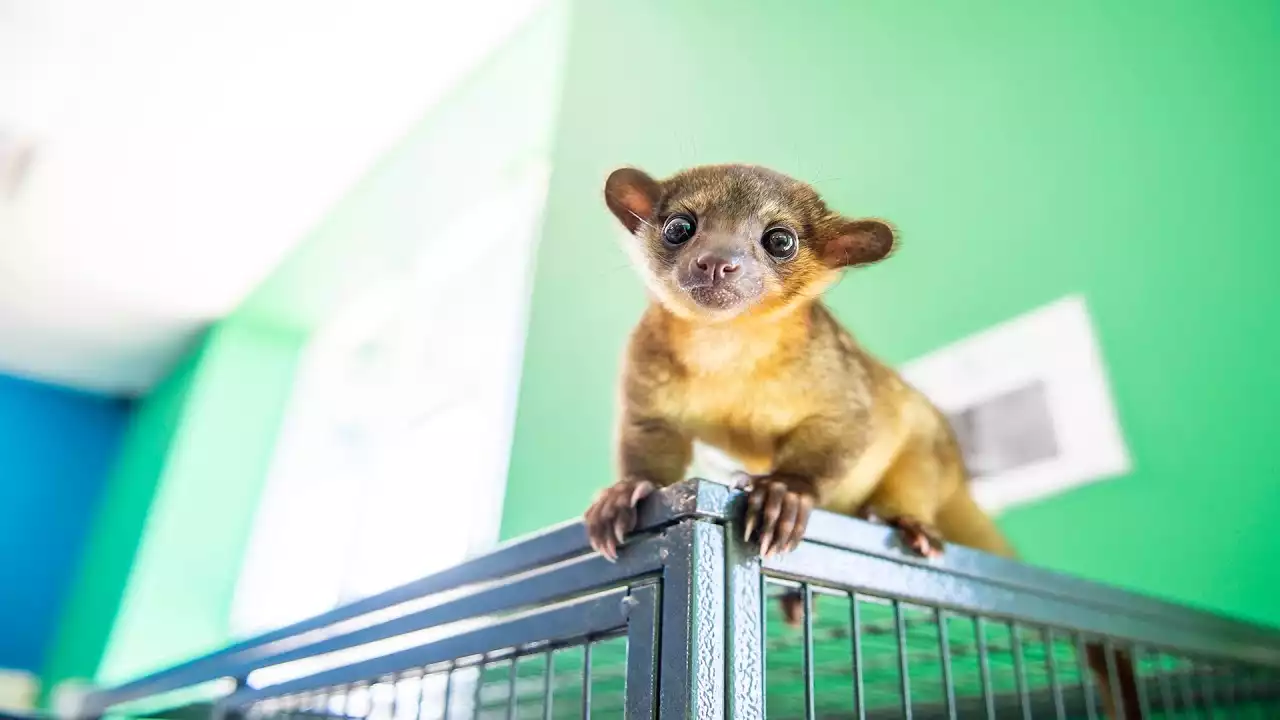Kinkajous are a species that many exotic animal enthusiasts dream of having in their home. These critters are one of the most interesting and unique animals available for private ownership. They’re also one of the most challenging to care for, which makes them a rare but exciting addition to any home. Kinkajous are arboreal creatures, which means they spend most of their time in trees. As nocturnal animals who love to climb, kinkajous require plenty of vertical space, as well as other amenities that create a “fake” tree structure indoors. Specifically, you’ll want lots of ropes and wood poles within their enclosure to mimic branches and tree trunks. If you don’t have the room or resources for such an elaborate setup, it may not be the right pet for you.
What is a Kinkajou?
A kinkajou is a small, brown, furry mammal native to South America. They can grow up to 18 inches long and are easily recognized by the distinctive band of white fur that runs from the top of their head all the way down their back. Kinkajous are arboreal animals, which means they spend most of their time in trees. They’re nocturnal, and primarily eat fruits, leaves, and flowers. Kinkajous are fascinating animals with lots of unique traits. They use their long, bushy tails to balance as they climb, and their extremely strong front claws are used for both climbing and digging. They also have incredibly long tongues that can be fully extended. Kinkajous are also the only mammals that can move their genitals between their leg muscles, which is completely unique to the species. Kinkajous are extremely rare and exotic animals, which makes them a thrilling addition to any home. However, they’re also the most challenging type of exotic pet to care for, and they require a significant time commitment.
Kinkajou Facts: the HONEY BEAR | Animal Fact Files
Kinkajou Behavior and Care
Kinkajous are very feisty, curious creatures. They’re also extremely intelligent, so you’ll need to be very patient and understanding when handling them. Kinkajous can be very aggressive, and often express their dominance by biting their owners. Kinks are incredibly territorial and need a lot of space to roam. As arboreal animals, they require plenty of vertical space, as well as ropes, poles, and trees indoors to create a “fake” tree structure. Kinkajous are also very messy animals that will make a huge mess with their food, bedding, and droppings. You’ll need to clean their enclosure daily, as well as change their bedding each week. It’s also a good idea to wear gloves when cleaning the kinkajou’s cage, as they can be a bit nippy. Kinkajous are also extremely intelligent, curious animals who will often try to escape their enclosure. If you notice your kinkajou attempting to climb out of their cage, make sure to get their enclosure as high off the ground as possible.
Kinkajou Diet
Kinkajous are primarily herbivorous, which means they primarily eat plants. To keep your kinkajou happy and healthy, you’ll need to give them a large number of fresh fruits and vegetables every day. In addition to the fresh food, you’ll also need to provide your kinkajou with some daily supplements, such as vitamins and minerals. Kinkajou food is extremely expensive and should be purchased online. Instead of purchasing bags of kinkajou food, many exotic animal owners prefer to grow their own fresh fruits and vegetables at home. This will save you a significant amount of money and give your kinkajou a healthier, more natural diet.
Choosing a Kinkajou
As with all exotic animals, you should thoroughly research your kinkajou’s needs before purchasing one. This will help you find the right kinkajou for your lifestyle, as well as give you an idea of how much your kinkajou will cost. Kinkajous are illegal in many states, but there is a huge black market for the critters. This makes them hard to track down and often very expensive, so you must be willing to spend a good amount of time and money looking. You should also make sure your kinkajou is fully grown when you get it. Most kinkajous grow very slowly, and it takes them between two and five years to fully mature. You want to make sure you get a kinkajou that is at least two years old, otherwise, it will never grow to its full size.
Not your Average Pet: Meet a Kinkajou in Saginaw
Conclusion
Kinkajous are the most challenging type of exotic pet to care for, but they’re also one of the most exciting and unique animals available. If you have the time, space, and resources to properly care for a kinkajou, they could be an excellent addition to your home. Finally, the kinkajou is a very interesting and unique animal. These creatures are one of the most exciting and difficult types of animal to care for, but they’re also one of the most fascinating.


 What Exactly is a Holistic Beauty Clinic?
What Exactly is a Holistic Beauty Clinic?
 The Biggest Film Studios Hollywood
The Biggest Film Studios Hollywood
 Some of the Best Luxury Shoe Designers Today
Some of the Best Luxury Shoe Designers Today Why You Should Keep Chinchillas as Pets
Why You Should Keep Chinchillas as Pets The Pros and Cons of Keeping Flying Squirrels
The Pros and Cons of Keeping Flying Squirrels The Affectionate and Adorable Fennec Fox
The Affectionate and Adorable Fennec Fox How to Care for a Capybara at Home
How to Care for a Capybara at Home